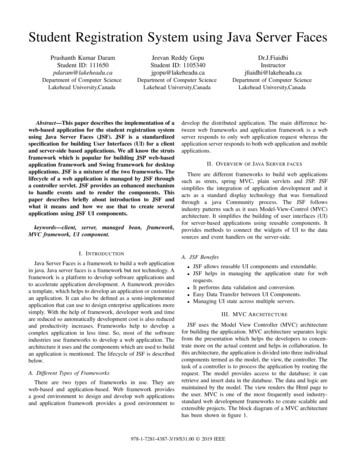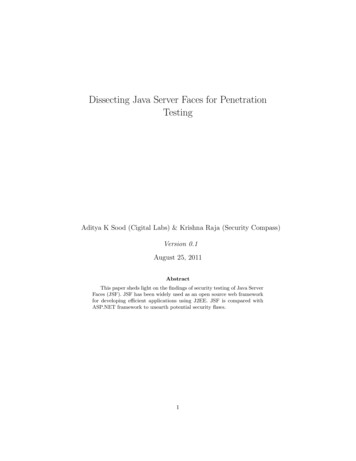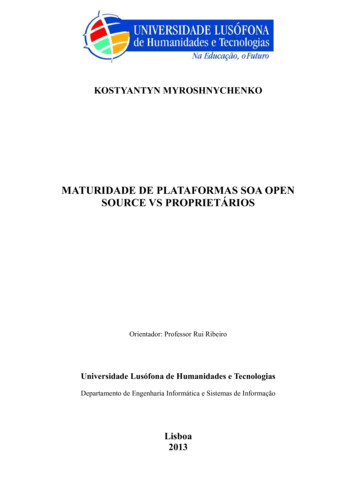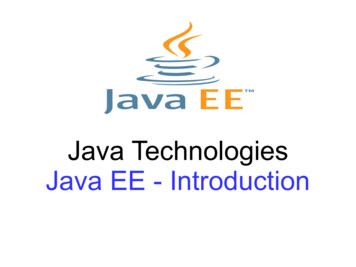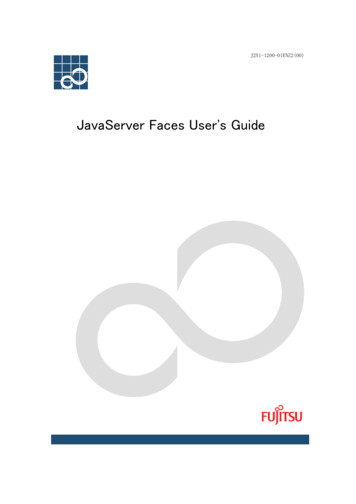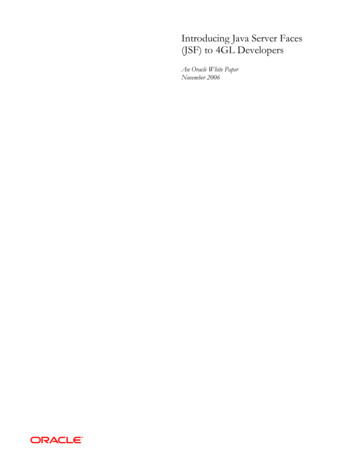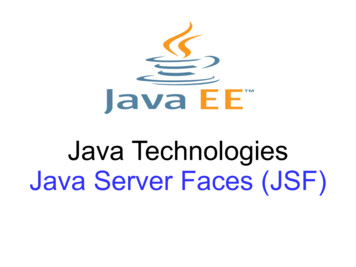
Transcription
Java TechnologiesJava Server Faces (JSF)
The Context“As far as the customer is concerned, the interface is the product”, Jef Raskin A Web user interface allows the user to interactwith content or software running on a remoteserver through a Web browser.Web Components (Servlets, JSP, Beans, etc.) “The Bricks” needed for creating Web Apps Frameworks are sets of design patterns, APIs,and runtime implementations intended tosimplify the design and coding process forbuilding new applications. Enable application developers to concentrate onthe unique feature set required by their applications.
User Interface Design Components–––– Input ControlsNavigational ComponentsInformational ComponentsContainersBest practices – UI should be:––––––Simple: “open, read, write, close”Consistent: “same layout, but in different colors”Informative: “clear messages – less complaints”Intelligent: “defaults and workflows”Responsive: “0.1s – 1s - 10s”Beautiful : “not really”
Web Application Frameworksprovide support for: Navigating among the application's pages Creating the presentation (forms, views, etc.) Accessing data (beans, etc.) and serverresources (JDBC connections, etc.) Data validation and conversion (web model) Internationalization Secure access to resources Role separation, .
Front Controller !-- Request Mapping -- servlet-mapping url-pattern *.do /url-pattern servlet-name com.some.mvc.framework.FrontController /servlet-name /servlet-mapping Provides a centralized entry point for handling requests
Java Server FacesServer-side component framework for building web applications: Offers an API for representing UI componentsand managing their server-side stateTag libraries for using components in pages andfor connecting them to server-side objectsEvent based interaction modelSupport for server-side validation, dataconversion; page navigation; internationalizationSimplifies the process of building andmaintaining web applications with server-sideuser interfaces
Server-Side UI
JSF Implementations“JSF is not what you've been told anymore”, Çağatay ÇiviciSpecifications: 1.0 (2004) 1.2 (2006) 2.0 (2009) 2.1 (2010) 2.2 (2013) 2.3 (2017) 3.0RC1 (2020)Implementations Reference (included in GlassFish) Open-Source, Ajax-enabled:PrimeFacesICEFacesJBoss RichFacesApache MyFaces, .RichInternetApplications
Creating a Simple JSF Application Create the backing bean(s) PersonBeanWrite the pages inputName.xhtml, sayHello.xhtmlCreate the resource bundle Messages.propertiesDefine navigation rules faces-config.xml
PersonBeanpackage hello;import javax.faces.bean.ManagedBean;import javax.faces.bean.RequestScoped;@ManagedBean(name "personBean")@RequestScopedpublic class PersonBean {private String name;public String getName() {return name;}public void setName(String name) {this.name name;}}the name of the beanthe visibility domain//CDI@Named("personBean") javax.inject.Named@RequestScoped javax.enterprise.context
inputName.xhtml html xmlns "http://www.w3.org/1999/xhtml"xmlns:h "http://java.sun.com/jsf/html" h:head title Hello /title /h:head h:body h:form h:outputLabel for "userName" value "Your name:"/ h:inputText id "userName"value "#{personBean.name}"required "true"/ h:commandButton id "submit"value "Submit"action "sayHello.xhtml"/ h:message id "errors" style "color: red"showSummary "true" showDetail "false"for "userName"/ /h:form /h:body /html
Messages.propertiesThe Resource Bundlecontains messages displayed by the application# key valuetitle Simple JSF Applicationgreeting Hello
sayHello.xhtml html xmlns "http://www.w3.org/1999/xhtml"xmlns:h "http://java.sun.com/jsf/html"xmlns:f "http://java.sun.com/jsf/core" f:loadBundle basename "hello.Messages" var "message"/ h:head title #{message.title} /title /h:head h:body h:form h2 #{message.greeting} #{personBean.name} ! /h2 h:commandButton id "back" value "Back"action "inputName.xhtml"/ /h:form /h:body /html
Page NavigationReplace actual file names with abstract actions: h:commandButton id "submit" value "Submit" action "sayHello.xhtml"/ "sayHello.xhtml" "hello"Define the navigation rules in faces-config.xml faces-config navigation-rule from-view-id /inputName.xhtml /from-view-id navigation-case from-outcome hello /from-outcome to-view-id /sayHello.xhtml /to-view-id /navigation-case /navigation-rule /faces-config
Configure JSF Environment inweb.xml web-app context-param param-name javax.faces.application.CONFIG FILES /param-name param-value /WEB-INF/faces-config.xml /param-value /context-param !-- Faces Servlet -- servlet servlet-name Faces Servlet /servlet-name servlet-class javax.faces.webapp.FacesServlet /servlet-class load-on-startup 1 /load-on-startup /servlet !-- Faces Servlet Mapping -- servlet-mapping servlet-name Faces Servlet /servlet-name url-pattern /faces/* /url-pattern /servlet-mapping /web-app
Configure JSF Environment infaces-config.xml faces-config version "2.2" application Default JSF messages message-bundle Messages /message-bundle resource-bundle Global Resource Bundles base-name Messages /base-name var msg /var /resource-bundle Supported Locales locale-config default-locale en /default-locale supported-locale ro /supported-locale /locale-config /application navigation-rule id "main" . /faces-config Navigation Rules
JSF Architecture“The learning curve is steep”, “We recommend teams use simple frameworks andembrace and understand web technologies including HTTP, HTML and CSS.”, etc.User Interface Component ModelComponent Rendering ModelBacking / Managed Beans ModelConversion ModelEvent and Listener ModelValidation ModelNavigation Model
User Interface Component Classes Specify the component functionality, such asholding component state, maintaining a reference to objects, driving eventhandling and rendering for a set of standard components. Base class: UIComponentBase subclass ofUIComponent, which defines the default state and behavior No definition of visual representation utUIMessage–UIDataUIColumnUIGraphic .
Behavioral Interfaces The component classes also implement one ormore behavioral interfaces, each of which defines certainbehavior for a set of components whose classes implement the interface.–ActionSource, ActionSource2ActionSource is an interface that may be implemented by any concrete UIComponent thatwishes to be a source of ActionEvents, including the ability to invoke application actions viathe default ActionListener mechanism.–ValueHolder, EditableValueHolder–NamingContainer, StateHolder, Examples:UICommandimplementsActionSource2, StateHolderUIOutputimplementsStateHolder, ValueHolderUIInputimplementsEditableValueHolder, StateHolder, ValueHolder
Component Rendering Model Renderer class the view of a component––define the behavior of a component oncecreate multiple renderers (Strategy Design Pattern)A Render kit defines how component classesmap to component tags that are appropriate fora particular client. The JavaServer Facesimplementation includes a standard HTMLrender kit for rendering to an HTML client. A component tag identifies the eListbox
Component Rendering Model Renderer class the view of a component––define the behavior of a component oncecreate multiple renderers (Strategy Design Pattern)A Render kit defines how component classesmap to component tags that are appropriate fora particular client. The JavaServer Facesimplementation includes a standard HTMLrender kit for rendering to an HTML client. A component tag identifies the eListbox
Backing / Managed Beans Model
Value BindingValue BindingPersonBean String name; h:inputText id "userName" value "#{personBean.name}"/ @ManagedBean(name "personBean")@SessionScopedpublic class PersonBean implements Serializable {private String name;public String getName() {return name;}public void setName(String name) {this.name name;}}
Reference BindingReference BindingPersonBean UIInput nameComponent; h:inputText id "userName" binding "#{personBean.nameComponent}"/ public class PersonBean {.private UIInput nameComponent;public UIInput getNameComponent() {return nameComponent;}public void setNameComponent(UIInput nameComponent) {this.nameComponent nameComponent;}public void someMethod() {nameComponent.setRendered(false);}}
The Conversion Model When a component is bound to a managedbean, the application has two views of thecomponent's data:–The model view, in which data is represented asdata types, such as java.util.Date,double,etc.–The presentation view, in which data isrepresented in a manner that can be read ormodified by the user, such as a text string in theformat 2014-10-29 or 1,234.99JSF automatically converts component databetween these two views when the bean property associatedwith the component is of one of the types supported by the component's data.
Using Standard Converters h:inputText value "#{personBean.salary}"converter "javax.faces.convert.BigDecimalConverter"/ h:outputText value "#{personBean.birthday}" f:convertDateTime pattern "yyyy-MM-dd"/ /h:outputText h:outputText value "#{product.price}" f:convertNumber type "currency" / /h:outputText
Using Custom Converters@FacesConverter(value "urlConverter")// or @FacesConverter(forClass "java.net.URL")// or using converter in faces-config.xmlpublic class URLConverter implements Converter {// Presentation - Modelpublic Object getAsObject(FacesContext context,UIComponent component, String newValue) throws ConverterException {try {return new URL(newValue);} catch(Exception e) {throw new ConverterException("Hey, conversion error!");}}// Model - Presentationpublic String getAsString(FacesContext context,UIComponent component, Object value) throws ConverterException {return String.valueOf(value);}} h:inputText id "url" value "#{bean.url}" converter "urlConverter" /
Converter Examplepublic abstract class AbstractConverter T implements Converter {public Object getAsObject(FacesContext context, UIComponent component, String value) {if (value null value.trim().equals("")) return null;try {return getAsObject(value);} catch (NoResultException e) {System.err.println("cannot convert " value "\n" e);return null;}}public String getAsString(FacesContext context, UIComponent component, Object value) {if (value null) return "";return getAsString(value);}protected abstract T getAsObject(String value);protected String getAsString(Object value) {return ((T) value).toString();}}@FacesConverter(forClass Country.class)public class CountryConverter extends AbstractConverter Country {@Overrideprotected Object getAsObject(String value) {return CountryRepository.findByName(value);}}
Converter Example (xhtml) p:selectOneMenu id "city"value "#{personEdit.city}"converter "#{cityConverter}" f:selectItems value "#{personEdit.cities}" / f:selectItem itemValue "#{null}" itemLabel "-" / /p:selectOneMenu p:selectOneMenu id "country" required "true"value "#{personEdit.country}" f:selectItems value "#{personEdit.countries}" / /p:selectOneMenu @ManagedBeanpublic class PersonEdit {private Country country;private City city;private List Country countries;private List City cities; //getters, setters}
Event and Listener Model Application Events––– Generated by UIComponentsActionEventValueChangeEventSystem Events–Generated during the execution of an application atpredefined times. They are applicable to the entireapplication rather than to a specific component:PostConstructApplicationEvent, PreDestroyApplicationEvent,PreRenderViewEvent Data Model Events–Occurs when a new row of a UIData component isselected
Registering Listeners An application developer can implement listeners asclasses or as managed bean methods.ActionListener h:commandLink id "create"action "createPerson" f:actionListener type "somepackage.SomeActionListener" / /h:commandLink ValueChangedListener h:inputText id "name" size "50"value "#{personBean.name}"required "true"valueChangeListener "#{personBean.nameChanged}" f:valueChangeListener type "somepackage.SomeValueChangeListener" / /h:inputText
Implementing Event ListenersUsing a classpublic class SomeActionListener implements ActionListener {@Overridepublic void processAction(ActionEvent ae)throws AbortProcessingException {UIComponent ui ae.getComponent();System.out.println("Event source is: " ui.getClass().getName());}}Using a backing bean methodpublic class PersonBean { public void nameChanged(ValueChangeEvent event) {System.out.println("Value change: " event.getOldValue() " - "event.getNewValue());}}
Validation Model We need to validate the local data of editablecomponents (such as text fields) before thecorresponding model data is updated to matchthe local value.–Standard validators h:inputText id "name" value "#{personBean.name}"required "true"/ f:validateLength minimum "1" maximum "50"/ /h:inputText –Custom validators bean methodsValidator classes
Using Custom Validators Using a validation method inside a beanpublic void validateEmail(FacesContext context,UIComponent component, Object value) {String email (String) value;if (email.indexOf(’@’) -1) essage(component.getClientId(context),new FacesMessage("Bad email"));}} h:inputText value "#{user.email}" validator "#{user.validateEmail}"/ Using a validator class@FacesValidator(value "emailValidator")public class EmailValidator implements Validator {public void validate(FacesContext context,UIComponent component, Object value) { throw new ValidatorException("Bad email");}} h:inputText id "email" value "#{user.email}" f:validator validatorId "emailValidator" / /h:inputText
Using Bean Validators The Bean Validation model is supported byconstraints in the form of annotations placed on afield, method, or class of a JavaBeanscomponent, such as a managed bean. Constraints can be built in or user defined. Examplepublic class Person {@Pattern(regexp " [a-z0-9!# %&'* / ? { } -] (?:\\.[a-z0-9!# %&'* / ? { } -] )*@(?:[a-z0-9](?:[a-z0-9-]*[a-z0-9])?\\.) [a-z09](?:[a-z0-9-]*[a-z0-9])?")@Size(max 100)@NotNullprivate String email; }
Validation error messages Use validatorMessge tag attribute p:inputText id "email"value "#{personEdit.entity.email}"validatorMessage "#{msg['email.invalid']}" . /p:inputText Or override the defaults: Messages.properties# # Converter Errors# javax.faces.converter.DateTimeConverter.DATE {2}: ''{0}'' could not be understood as a date.javax.faces.converter.DateTimeConverter.DATE detail {2}: ''{0}'' could not be understood as a date. Example: {1}.# # Validator Errors# javax.faces.validator.LengthValidator.MAXIMUM {1}: Validation Error: Length is greater than allowable maximum of UM {1}: Validation Error: Length is less than allowable minimum of ''{0}''.
The Navigation Model Navigation is a set of rules for choosing thenext page or view to be displayed after anapplication action, such as when a button or link is clicked. h:commandButton id "submit" value "Submit" action "success"/ ActionEvent default ActionListener NavigatorHandler Navigation can be–implicit: “success” success.xhtml–user-defined: configured in the applicationconfiguration resource files (faces-configx.xml) navigation-rule from-view-id /greeting.xhtml /from-view-id navigation-case from-outcome success /from-outcome to-view-id /response.xhtml /to-view-id /navigation-case /navigation-rule /greeting.xhtmlsuccess/response.xhtml
The Lifecycle of a JSF Application Receive incoming HTTP request made by the client– Decode parameters from the request– validate and convert the input dataModify and save the state– initial requests and postbacksA page is represented by a tree of components, called aview. The view is built considering the state saved from aprevious submission of the page.Render the response to the clientFacesContext contains all of the per-request state information related to the processing of asingle JavaServer Faces request, and the rendering of the corresponding response. It ispassed to, and potentially modified by, each phase of the request processing lifecycle.
Request – Response in JSFBuilds the view of the page, wires eventhandlers and validators to components in theview, and saves the view in the FacesContextinstanceeach componentEachcomponent inin thethe treetree extractsextracts itsits newnewvalue from the request parameters by using itsdecode (processDecodes())method. The value ismethod.then storedThe locallyvalueis thenoneachstoredcomponent.locally on each component.The data is valid. The corresponding server-sideobject properties (the bean properties pointed atby an input component's value attribute) are setto the components' local values.Delegates authority to the appropriate resourcefor rendering the pages. If the request is apostback and errors were encountered, theoriginal page is rendered again.
Monitoring the Lifecyclepublic class PhaseLogger implements PhaseListener {public PhaseLogger() {System.out.println("PhaseLogger created.");}public void beforePhase(PhaseEvent event) {System.out.println("BEFORE - " event.getPhaseId());}public void afterPhase(PhaseEvent event) {System.out.println("AFTER - " event.getPhaseId());}public PhaseId getPhaseId() {return PhaseId.ANY PHASE;}}faces-config.xml lifecycle phase-listener myapp.listeners.PhaseLogger /phase-listener /lifecycle
The immediate attribute The immediate attribute indicates whether userinputs are to be processed early in theapplication lifecycle or later.“Flag indicating that, if this component isactivated by the user, notifications should bedelivered to interested listeners and actionsimmediately (that is, during Apply RequestValues phase) rather than waiting until InvokeApplication phase.”Use case: the Cancel button in a dialog
JSF and AJAX AJAX Asynchronous JavaScript and XML.Uses JavaScript (XMLHttpRequest)to senddata to the server and receive data from theserver asynchronously.The javascript code exchanges data with theserver and updates parts of the web pagewithout reloading the whole page. f:ajax (in PrimeFaces p:ajax )
Ajax Events and Listeners Events: click, keyup, mouseover, focus, blur, etc h:outputText id "random" value "#{someBean.randomNumber}"/ h:selectBooleanCheckbox value "Check box" f:ajax event "click" render "random"/ /h:selectBooleanCheckbox Listeners f:ajax listener "#{someBean.someAction}" render "someComponent" / public class SomeBean {public void someAction(AjaxBehaviorEvent event) {//do something .}}PrimeFaces p:ajax event "keyup"–selectOne: changeprocess "list of comp ids"–calendar: change, dateSelectupdate "list of comp ids" / –dataTable: rowSelect, rowDblSelect–autoComplete: itemSelect–dialog: closeFrequent use cases
Naming Containers Naming containers affect the behavior of theUIComponent.findComponent(java.lang.String)and UIComponent.getClientId() methods Forms, Trees, DataTables, etc. Example h:outputText id "test" value "Hello 1" / h:form id "form1" h:outputText id "test" value "Hello 2" / /h:form h:form id "form2" h:outputText id "test" value "Hello 3" / /h:form . f:ajax event "click" render "test"/ f:ajax event "click" render ":form1:test"/ f:ajax event "click" render ":form2:test"/ relative:absolute
Poll Polling is the continuous checking of otherprograms or devices by one progam or deviceto see what state they are in. p:poll makes ajax calls periodically: p:poll interval "3"listener "#{counterBean.increment}"update "counter" / h:outputText id "counter"value "#{counterBean.count}" /
Web Push One-way, server-to-client, websocket basedcommunication. f:websocket (JSF 2.3 ) f:websocket channel "push" f:ajax event "updateMyData" render ":dataTable" / /f:websocket @Push@Inject @Pushprivate PushContext push; public void someMethod() {push.send("updateMyData");}What is thewebsocketprotocol?
Facelets
The Context JSF offers an API for representing UIcomponents and managing their server-sidestate– html basic (h), jsf core (f) custom tag librariesWhat language do we use to actually write thepages?–First attempt: JSP–.
Using JSP in JSFhello.jsp %@page contentType "text/html" pageEncoding "UTF-8"% %@taglib prefix "h" uri "http://java.sun.com/jsf/html"% f:view html head title JSF - JSP /title /head body h:outputText value "Hello"/ /body /html /f:view servlet-mapping servlet-name Faces Servlet /servlet-name url-pattern /faces/* /url-pattern /servlet-mapping ost:8080/myapp/faces/hello.jsp
What Is Facelets? Page declaration language that is used tobuild JavaServer Faces views using HTML styletemplates and to build component trees.Use of XHTML for creating web pagesSupport for Facelets tag libraries in addition toJavaServer Faces and JSTL tag libraries Support for the Expression Language (EL) Templating for components and pages Composite components Faster compilation time, High-performance rendering, etc.
Using Faceletshello.xhtml html xmlns "http://www.w3.org/1999/xhtml"xmlns:h "http://java.sun.com/jsf/html" h:head title Hello JSF - Facelets /title /h:head h:body h:outputText value "Hello"/ /h:body /html http://localhost:8080/myapp/faces/hello.xhtml servlet-mapping servlet-name Faces Servlet /servlet-name url-pattern /faces/* /url-pattern /servlet-mapping
Facelets LibrariesURI: http://java.sun.com/ PrefixJSF Faceletsjsf/faceletsui:JSF Composite jsf/compositecomposite:JSF HTMLjsf/htmlh:JSF Corejsf/coref:JSTL Corejsp/jstl/corec:JSTL Functions jstl/functionsfn:
Facelets Templates JavaServer Faces technology provides the tools toimplement user interfaces that are easy to extendand reuse.Templating is a useful Facelets feature that allows youto create a page that will act as the base, ortemplate, for the other pages in an application.By using templates, you can reuse code and avoidrecreating similarly constructed pages. Templatingalso helps in maintaining a standard look and feel inan application with a large number of pages.
Using Facelets Templatestemplate.xhtml html xmlns "http://www.w3.org/1999/xhtml"xmlns:ui "http://java.sun.com/jsf/facelets"xmlns:h "http://java.sun.com/jsf/html" h:head title Facelets Template /title /h:head Top SectionMain ContentBottom Section h:body div id "top" class "top" ui:insert name "top" Top Section /ui:insert /div div id "content" class "main" ui:insert name "content" Main Content /ui:insert /div div id "bottom" class "bottom" ui:insert name "bottom" Bottom Section /ui:insert /div /h:body /html
Creating a Page from a Templatehello.xhtml ui:composition template "/WEB-INF/template.xhtml"xmlns "http://www.w3.org/1999/xhtml"xmlns:ui "http://java.sun.com/jsf/facelets"xmlns:h "http://xmlns.jcp.org/jsf/html"xmlns:c "http://xmlns.jcp.org/jsp/jstl/core" ui:define name "top" Welcome to Facelets /ui:define ui:define name "content" h:graphicImage value "#{resource[’images:hello.jpg’]}"/ h:outputText value "Hello Facelets!"/ /ui:define ui:define name "bottom" h:outputLabel value "Power to the Facelets"/ /ui:define /ui:composition
Using Parameters template.xhtml html . f:view contentType "text/html" encoding "UTF-8" h:head f:facet name "first" title #{pageTitle} /title /f:facet /h:head /html hello.xhtml ui:composition template "/WEB-INF/template.xhtml" . ui:param name "pageTitle" value "#{msg['main.title']}" / . /ui:composition
Composite Components A composite component is a special type of templatethat acts as a component.Any component is essentially a piece of reusable codethat behaves in a particular way.A composite component consists of a collection ofmarkup tags and other existing components. Thisreusable, user-created component has a customized,defined functionality and can have validators,converters, and listeners attached to it like any othercomponent. Using the resources facility, the composite componentcan be stored in a library that is available to theapplication from the defined resources location.
Creating a Composite Componentresources/ezcomp/email.xhtml html xmlns "http://www.w3.org/1999/xhtml"xmlns:composite "http://java.sun.com/jsf/composite"xmlns:h "http://java.sun.com/jsf/html" h:head title This content will not be displayed /title /h:head h:body composite:interface composite:attribute name "value" required "false"/ /composite:interface composite:implementation h:outputLabel value "Email id: " / h:inputText value "#{cc.attrs.value}" / /composite:implementation /h:body /html
Using a Composite ComponentsomePage.xhtml html xmlns "http://www.w3.org/1999/xhtml"xmlns:h "http://java.sun.com/jsf/html"xmlns:ez "http://java.sun.com/jsf/composite/ezcomp/" h:head title Using a sample composite component /title /h:head body h:form ez:email value "Enter your email id" / /h:form /body /html
Web Resources Web resources are any software artifacts thatthe web application requires for properrendering, including images, script files, andany user-created component libraries.Resource identifiers are unique strings thatconform to the following sion/]resource-name[/resource-version] h:graphicImage value "#{resource['images:wave.med.gif']}"/ This tag specifies that the image named wave.med.gif is in the directory resources/images.
PrimeFaces SHOWCASE PrimeFaces is a popular open sourceframework for JavaServer Faces featuring over100 components, touch optimized mobilekit,client side validation, theme engine and more.Check l
Java Server Faces Offers an API for representing UI components and managing their server-side state Tag libraries for using components in pages and for connecting them to server-side objects Event based interaction model Support for server-side validation, data conversion; page navigation; internationalization Simplifies the process of building and

